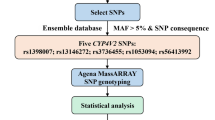Abstract
To investigate the impact of PLA2G7 polymorphism, and additional their interactions with smoking and drinking on coronary heart disease (CHD) risk based on Chinese population. GMDR model was used to screen the best gene–smoking and gene–drinking interaction combinations. Logistic regression was performed to investigate association between 4 SNPs and CHD, and the interaction effect between rs1805017 and smoking. For CHD patient–control haplotype analyses, the SHEsis online haplotype analysis software (http://analysis.bio-x.cn/myAnalysis.php) was employed. CHD risks were higher in carriers of homozygous mutant of rs1805017 and rs1805018 than those with wild-type homozygotes, OR (95% CI) were 1.45 (1.16–1.92) and 1.51 (1.23–1.97), respectively, but the other two SNPs, rs16874954 and rs1051931 were not significant associated with CHD risks. GMDR analysis indicated that there was a significant two-locus model (p = 0.0107) involving rs1805017 and smoking, indicating a potential gene–environment interaction between rs1805017 and smoking. But we did not found any gene–drinking and gene–gene interaction combinations in GMDR models. The haplotype R-I was observed most frequently in two groups, with 47.43 and 54.38% in the case and control group of the population, respectively. The results also indicated that the haplotype containing the rs1805017-H and rs1805018-T alleles were associated with a statistically increased CHD risk, OR (95% CI) 1.43 (1.10–1.86), p = 0.0021. Polymorphisms in rs1805017 and rs1805018, additional interaction between rs1805017 and smoking, and haplotype containing the rs1805017-H and rs1805018-T alleles were associated with increased CHD risk.
Similar content being viewed by others
References
Lopez AD, Mathers CD, Ezzati M, Jamison DT, Murray CJ (2006) Global and regional burden of disease and risk factors, 2001: systematic analysis of population health data. Lancet 367:1747–1757
Daka B, Olausson J, Larsson CA, Hellgren MI, Råstam L, Jansson PA, Lindblad U (2015) Circulating concentrations of endothelin-1 predict coronary heart disease in women but not in men: a longitudinal observational study in the Vara-Skovde Cohort. BMC Cardiovasc Disord 15:146
Hu Z, Yuan X, Rao K, Zheng Z, Hu S (2014) National trend in congenital heart disease mortality in china during 2003 to 2010: a population-based study. J Thorac Cardiovasc Surg 148(2):596–602.e1
Mega JL, Stitziel NO, Smith JG, Chasman DI, Caulfield MJ, Devlin JJ, Nordio F, Hyde C, Cannon CP, Sacks F, Poulter N, Sever P, Ridker PM, Braunwald E, Melander O, Kathiresan S, Sabatine MS (2015) Genetic risk, coronary heart disease events, and the clinical benefit of statin therapy: an analysis of primary and secondary prevention trials. Lancet 385:2264–2271
Marenberg ME, Risch N, Berkman LF, Floderus B, de Faire U (1994) Genetic susceptibility to death from coronary heart disease in a study of twins. N Engl J Med 330:1041–1046
Alkandari JR, Andersen LB, Bauman AE, Blair SN, Brownson RC, Bull FC, Craig CL, Ekelund U, Goenka S, Guthold R, Hallal PC, Haskell WL, Heath GW, Inoue S, Kahlmeier S, Katzmarzyk PT, Kohl HW 3rd, Lambert EV, Lee IM, Leetongin G, Lobelo F, Loos RJ, Marcus B, Martin BW, Owen N, Parra DC, Pratt M, Puska P, Ogilvie D, Reis RS, Sallis JF, Sarmiento OL, Wells JC (2012) Effect of physical inactivity on major non-communicable diseases worldwide: an analysis of burden of disease and life expectancy. Lancet 380(9838):219–229
Charniot JC, Khani-Bittar R, Albertini JP, Giral P, Cherfils C, Cosson C, Guillerm E, Leprince P, Gandjbakhch I, Bonnefont-Rousselot D (2013) Interpretation of lipoprotein-associated phospholipase A2 levels is influenced by cardiac disease, comorbidities, extension of atherosclerosis and treatments. Int J Cardiol 168:132–138
Gao W, He HW, Wang ZM, Zhao H, Lian XQ, Wang YS, Zhu J, Yan JJ, Zhang DG, Yang ZJ, Wang LS (2012) Plasma levels of lipometabolism-related miR-122 and miR-370 are increased in patients with hyperlipidemia and associated with coronary artery disease. Lipids Health Dis 11:55
Dada N, Kim NW, Wolfert RL (2002) Lp-PLA2: an emerging biomarker of coronary heart disease. Expert Rev Mol Diagn 2:17–22
Corson MA, Jones PH, Davidson MH (2008) Review of the evidence for the clinical utility of lipoprotein-associated phospholipase A2 as a cardiovascular risk marker. Am J Cardiol 101:41F–50F
Xu L, Zhou J, Huang S, Huang Y, Le Y, Jiang D, Wang F, Yang X, Xu W, Huang X, Dong C, Zhang L, Ye M, Lian J, Duan S (2013) An association study between genetic polymorphisms related to lipoprotein-associated phospholipase A (2) and coronary heart disease. Exp Ther Med 5:742–750
Liu PY, Li YH, Wu HL, Chao TH, Tsai LM, Lin LJ, Shi GY, Chen JH (2006) Platelet-activating factor-acetylhydrolase A379V (exon 11) gene polymorphism is an independent and functional risk factor for premature myocardial infarction. J Thromb Haemost 4:1023–1028
Ninio E, Tregouet D, Carrier JL, Stengel D, Bickel C, Perret C, Rupprecht HJ, Cambien F, Blankenberg S, Tiret L (2004) Platelet-activating factor-acetylhydrolase and PAF-receptor gene haplotypes in relation to future cardiovascular event in patients with coronary artery disease. Hum Mol Genet 13:1341–1351
Hong M, Zhang M, Lu X (2015) Nonsynonymous polymorphisms in PLA2G7 gene are associated with the risk of coronary heart disease in a southern Chinese population. Mamm Genome 26(3–4):191–199
Miller SA, Dykes DD, Polesky HF (1988) A simple salting out procedure for extracting DNA from human nucleated cells. Nucleic Acids Res 16:1215
Furberg CD, Nelson JJ, Solomon C, Cushman M, Jenny NS, Psaty BM (2008) Distribution and correlates of lipoprotein-associated phospholipase A2 in an elderly cohort: the Cardiovascular Health Study. J Am Geriatr Soc 56:792–799
Persson M, Nilsson J, Nelson JJ, Hedblad B, Berglund G (2007) The epidemiology of Lp-PLA2: distribution and correlation with cardiovascular risk factors in a population-based cohort. Atherosclerosis 190:388–396
Garg PK, McClelland RL, Jenny NS, Criqui MH, Greenland P, Rosenson RS, Siscovick DS, Jorgensen N, Cushman M (2015) Lipoprotein-associated phospholipase A2 and risk of incident cardiovascular disease in a multi-ethnic cohort: the multi ethnic study of atherosclerosis. Atherosclerosis 241(1):176–182
Wang Q, Hao Y, Mo X, Wang L, Lu X, Huang J, Cao J, Li H, Gu D (2010) PLA2G7 gene polymorphisms and coronary heart disease risk: a meta-analysis. Thromb Res 126:498–503
Li L, Qi L, Lv N, Gao Q, Cheng Y, Wei Y, Ye J, Yan X, Dang A (2011) Association between lipoprotein-associated phospholipase A2 gene polymorphism and coronary artery disease in the Chinese Han population. Ann Hum Genet 75:605–611
Hou L, Chen S, Yu H, Lu X, Chen J, Wang L, Huang J, Fan Z, Gu D (2009) Associations of PLA2G7 gene polymorphisms with plasma lipoprotein-associated phospholipase A2 activity and coronary heart disease in a Chinese Han population: the Beijing atherosclerosis study. Hum Genet 125:11–20
Sutton BS, Crosslin DR, Shah SH, Nelson SC, Bassil A, Hale AB, Haynes C, Goldschmidt-Clermont PJ, Vance JM, Seo D, Kraus WE, Gregory SG, Hauser ER (2008) Comprehensive genetic analysis of the platelet activating factor acetylhydrolase (PLA2G7) gene and cardiovascular disease in case-control and family datasets. Hum Mol Genet 17:1318–1328
Du W, Li Q, Lu Y, Yu X, Ye X, Gao Y, Ma J, Cheng J, Cao Y, Du J, Shi H, Zhou L (2011) Genetic variants in ADIPOQ gene and the risk of type 2 diabetes: a case–control study of Chinese Han population. Endocrine 40(3):413–422
Luo J, Rossouw J, Margolis KL (2013) Smoking cessation, weight change, and coronary heart disease among postmenopausal women with and without diabetes. JAMA 310(1):94–96
Acknowledgements
The writing of this paper was supported by the Anzhen hospital and Baotou Fourth Hospital. We thank all the partners and staffs who help us in the process of this study.
Author information
Authors and Affiliations
Corresponding author
Ethics declarations
Conflict of interest
The authors declare that they have no conflict of interest.
Ethical approval
All procedures performed in studies involving human participants were in accordance with the ethical standards of the institutional and/or national research committee and with the 1964 Helsinki declaration and its later amendments or comparable ethical standards.
Informed consent
Informed consent was obtained from all individual participants included in the study.
Rights and permissions
About this article
Cite this article
Chi, Y., Shi, C., Zhang, X. et al. Interaction between nonsynonymous polymorphisms in PLA2G7 gene and smoking on the risk of coronary heart disease in a Chinese population. J Thromb Thrombolysis 46, 125–130 (2018). https://doi.org/10.1007/s11239-018-1671-9
Published:
Issue Date:
DOI: https://doi.org/10.1007/s11239-018-1671-9




